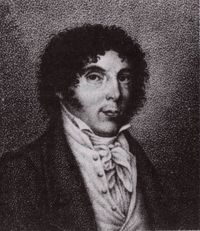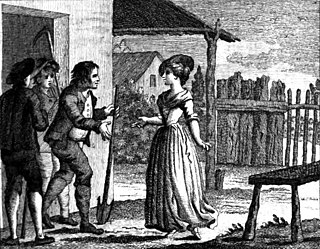Related Research Articles

Le donne curiose is an opera in three acts by Ermanno Wolf-Ferrari to a text by Luigi Sugana after Carlo Goldoni's play of the same name.

Il Guarany is an opera ballo composed by Antônio Carlos Gomes, based on the novel O Guarani by José de Alencar. Its libretto, in Italian rather than Gomes' native Portuguese, was written by Antonio Scalvini and Carlo D'Ormeville. The work is notable as the first Brazilian opera to gain acclaim outside Brazil. Maria Alice Volpe has analysed the historical subtext of the Indianismo movement behind Il Guarany.
Telemaco, ossia L'isola di Circe is an operatic dramma per musica in two acts by Christoph Willibald Gluck. The Italian libretto was written by Marco Coltellini after Carlo Sigismondo Capece's libretto for Scarlatti's 1718 opera Telemaco.

Fra i due litiganti il terzo gode is a dramma giocoso in two acts by Giuseppe Sarti. The libretto was after Carlo Goldoni's Le nozze.

Calliroe is an opera by Antonio Sacchini, set to a libretto by Mattia Verazi. It was first performed in Ludwigsburg on 11 February 1770 and the ballets were set by French choreographer Louis Dauvigny.
Il Palazzo incantato or Il Palagio d’Atlante, overo La Guerriera Amante is an opera in a prologue and three acts by the Italian composer Luigi Rossi. The libretto, by Giulio Rospigliosi, the future Pope Clement IX, is based on Ariosto's Orlando furioso. It was first performed in Rome in a lavish production at the Teatro delle Quattro Fontane on 22 February 1642. Rossi was criticised for giving too much music to his friend, the castrato Marc'Antonio Pasqualini, who played Bradamante, at the expense of the other roles. Some of the highly complicated stage machinery failed to work during the performance. Revived by Opera Dijon in a January 2021 online production.
Il Mitridate Eupatore is an opera seria in five acts by the Italian composer Alessandro Scarlatti with a libretto by Girolamo Frigimelica Roberti. It was first performed, with the composer conducting, at the Teatro San Giovanni Grisostomo, Venice, on 5 January 1707. A failure at its premiere, Mitridate Eupatore is now considered one of the finest of Scarlatti's operas.

Il re is a novella or opera in one act and three scenes by composer Umberto Giordano to an Italian libretto by Giovacchino Forzano. The opera premiered at La Scala in Milan on 12 January 1929.

Il burbero di buon cuore is an opera dramma giocoso in two acts by Vicente Martín y Soler. The Italian libretto by Lorenzo Da Ponte is based on the French comedy Le bourru bienfaisant by Carlo Goldoni. The opera premiered on January 4, 1786 in Vienna at the Burgtheater with a cast that included three well known Viennese singers of the day: Nancy Storace as Angelica, Francesco Benucci as Ferramondo, and Maria Mandini as Marina. The opera premiered in the same year and at the same house as Mozart's Le nozze di Figaro, and both operas enjoyed revivals at the Burgtheater three years later – each boasting two new arias for new leading ladies. The new arias for Il burbero di buon cuore were actually composed by Mozart, as Martín y Soler had left Vienna to work at the court of Catherine the Great in Saint Petersburg. The opera recently received its first modern revival in 2007 at the Teatro Real in Madrid, a performance which was videotaped live and released on DVD in 2009.
Demofoonte is a dramma per musica or opera in 3 acts by composer Christoph Willibald Gluck. The work uses an Italian language libretto by Pietro Metastasio. The opera premiered on 6 January 1743 at the Teatro Regio Ducale in Milan.

Il Pompeo is a dramma per musica in three acts by composer Alessandro Scarlatti. Written in 1682 when Scarlatti was 22 years old, it was his fourth opera and first dramatic work on a serious and grand subject. The opera uses an Italian language libretto by Nicolò Minato which had previously been used by Francesco Cavalli for his 1666 opera Pompeo Magno. The work premiered at the Teatro di Palazzo Colonna in Rome on 25 January 1683.

L'honestà negli amori is a dramma per musica in 3 acts by composer Alessandro Scarlatti. Written in 1679-1680 when Scarlatti was 19 years old, it was his second opera. The opera uses an Italian language libretto that was written by either D F Bernini or Domenico Filippo Contini. The work premiered at the Teatro di Palazzo Bernini in Rome on 3 February 1680. The opera was performed again in 1682 in Acquaviva delle Fonti at the Palazzo De Mari with Acquaviva laureata a serenata composed by Giovanni Cesare Netti.

Il finto astrologo is an intermezzo by composer Niccolò Piccinni. The opera uses an Italian language libretto by Carlo Goldoni. The work premiered at the Teatro Valle in Rome on 7 February 1765 with a cast that included the famous castrato Venanzio Rauzzini as Clarice.

Giovanni Galzerani was an Italian choreographer, ballet dancer, and composer who was active in major theatres throughout Italy from 1808 to 1853. He was born in Porto Azzurro on the Isle of Elba and began his education in Gaeta where his father was the military commandant at the time. At his father's wish he enrolled in the Collegio della Nunziatella in Naples to train for a military career, remaining there until the age of 17. While at the college, he also studied ballroom dancing with Ferdinando Gioia, the brother of the celebrated dancer and choreographer Gaetano Gioia, and became one of his best pupils. After his father's death in 1806, Galzerani abandoned preparations for a military career and dedicated himself entirely to the ballet, first as a dancer and then as a choreographer. He also composed the music for some of his ballets, such as Il pericolo which premiered in 1818 at the Teatro Regio in Turin.

Stefano Pavesi was an Italian composer. Born in Casaletto Vaprio, he is primarily known as a prolific opera composer, but he also served as the maestro di cappella of Crema Cathedral from 1818 until his death in Crema at the age of 71.

Il filosofo di campagna is a dramma giocoso per musica in 3 acts by composer Baldassare Galuppi. The opera uses an Italian language libretto by Carlo Goldoni. The work premiered at the Teatro San Samuele in Venice on 26 October 1754.
Il trionfo di Clelia, Wq. 31, is an opera composed by Christoph Willibald Gluck. It takes the form of a dramma per musica in three acts. The Italian-language libretto by Pietro Metastasio is based on several semi-legendary narratives concerning the founding of the Roman Republic. The opera premiered on 14 May 1763 at the Teatro Comunale di Bologna. Although rarely performed since then, it was revived in London in 2012 at the Royal Opera House's Linbury Studio.

Maria Carbone was an Italian operatic soprano. She created the lead female roles in two of Gian Francesco Malipiero's operas: the title role in Ecuba and Cleopatra in Antonio e Cleopatra.
Mattia Verazi was an Italian librettist primarily active at the court of Charles Theodore in Mannheim. He became known as the leader of a group of librettists who challenged the conventions of opera seria in the mid-18th century and was a long-time collaborator of composer Niccolò Jommelli. He also produced the libretti for Salieri's Europa riconosciuta, Sacchini's Calliroe, and J. C. Bach's Temistocle
References
- 1 2 Casaglia, Gherardo (2005). "Calliroe, 3 January 1808" . L'Almanacco di Gherardo Casaglia (in Italian).
| | This article about an Italian language opera is a stub. You can help Wikipedia by expanding it. |